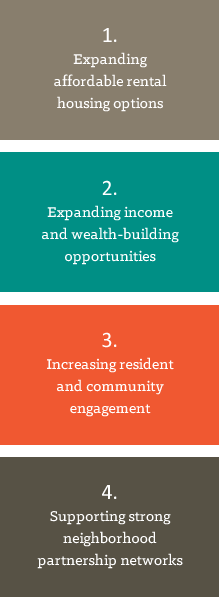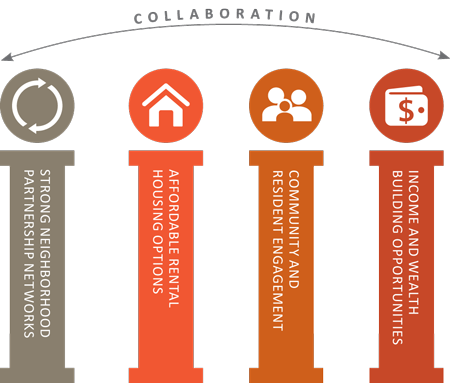Healthy Neighborhoods Approach
Research shows that our health and well-being is dependent on a range of interconnected social, economic and physical factors that impact the environments where people live, learn, work, and play. These factors and the resulting health inequities specifically play out at the neighborhood level.
Through our Healthy Neighborhoods approach to community development, we are evaluating each neighborhood where we work through the lens of these factors.
Our projects, programs and neighborhood collaborations will typically impact multiple factors at any one time. We also understand these factors are not static and have impacts of varying magnitude across life stages.
Strategic Partnerships and Collaboration
Certain factors—housing options, income and wealth, and social cohesion—have always and will continue to be central to the work of EBALDC. Over the past several years, we have also become more focused on working with coalitions of residents, community partners, businesses, and public agencies to understand the needs and priorities of specific neighborhoods. From there, we build on strategic partnership and collaboration opportunities, and leverage our own organizational expertise and strengths, in order to have the greatest impact on those priorities.
Community Impact
Our Healthy Neighborhoods approach focuses on achieving four core community impacts:
- Expanding affordable rental housing options
- Expanding income and wealth-building opportunities
- Increasing resident and community engagement
- Supporting strong neighborhood partnership networks
Our approach includes:
- convening or participating in collaborations that align residents, businesses, community partners and public agencies around a shared vision for neighborhood health and well-being
- project or program specific partnership opportunities focused on increasing housing options, income and wealth-building opportunities
- resident and community engagement.
We are committed to prioritizing those that support and connect with other neighborhood health factors (e.g. a transit-oriented mixed-use development that combines affordable housing, a neighborhood grocery store, and a preschool center; or a financial services collaboration that has a dual focus on supporting parents’ financial stability and their children’s school success).
Healthy Neighborhoods Four Community Impacts

Four Pillars of our Healthy Neighborhoods Approach

Learn More
To find out more about our organization, read more About Us.



